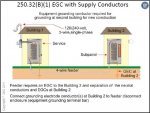- Location
- Placerville, CA, USA
- Occupation
- Retired PV System Designer
If the feed through lugs are protected by the 200A main breaker and the feeder to the main house is rated for 200A, then it will not be a tap.Feeding it from a breaker in the service panel would make it a feeder and not a feeder tap so the tap rules and 230.3 would not apply, making it compliant to run through the interior of the garage, right?
If you are just double lugging the input side of the panel, then the conductors will not be protected by the main breaker, and will be a service tap regardless of their size.
A tap situation is one where the smallest OCPD upstream of the tap wires has a higher rating than the allowed ampacity of the tap wires.


